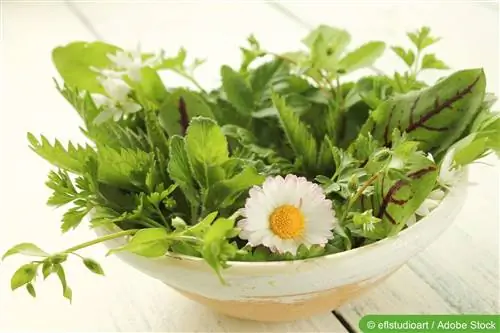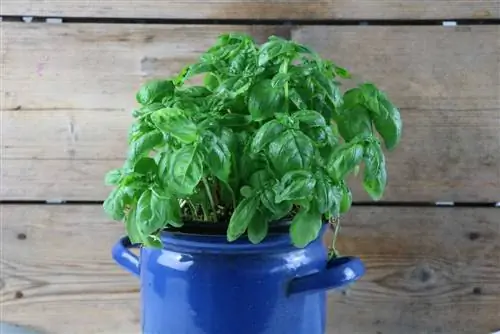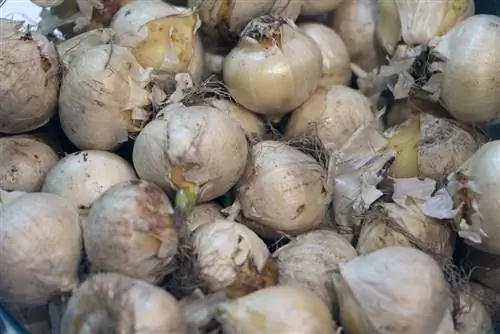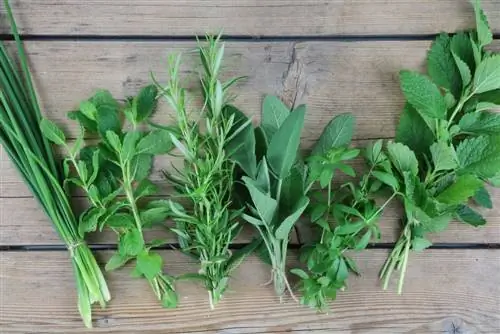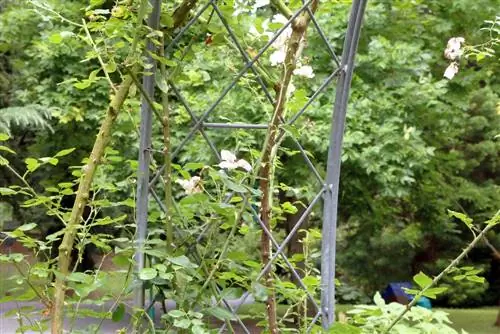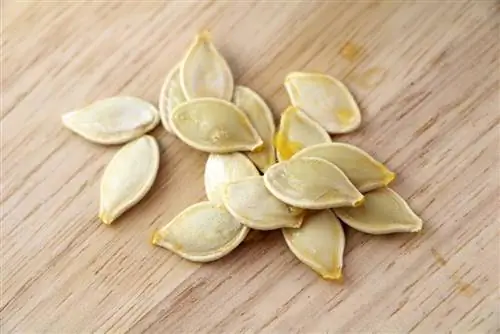- Author admin [email protected].
- Public 2023-12-17 03:39.
- Last modified 2025-01-24 12:45.
Many people would consider wild herbs to be weeds. They are full of vitamins, secondary plant ingredients, trace elements and are extremely tasty. The delicacies are real energy donors and some wild herbs have even proven themselves as medicinal plants.
The edible plants from the wild enrich many dishes in the kitchen and are often used in salads. They thrive in fields, meadows, river floodplains, forests or on the edge of paths. Collected, harvested and preserved at the right time, they can be enjoyed all year round.
Tips about wild herbs
Wild herbs are culinary delicacies, but not every wild plant is edible. Among them there are numerous poisonous plants. Anyone who collects herbs in nature should only harvest as much as can be processed. Unused herbs can be preserved. Wild herbs can be preserved in vinegar and oil, frozen, dried or preserved in other ways.
Harvest
Before the wild herbs can be preserved, they must first be collected. It is not advisable to dig up the entire plant including the roots and never to collect all the flowers and leaves. This is the only way the plant can continue to grow. Harvesting rare plants is taboo! The wild treasures are worthless if they turn black after drying. They are best transported in an airy basket. They can rot in plastic bags.
Identifying plants
- Wild herbs must be clearly identified.
- Species such as dandelions, nettles or daisies can be easily identified.
- Some plants can sometimes be confused.
- Representatives of the umbelliferous family are difficult to distinguish.
- Be sure to stay away from unknown herbs.
Collection locations
- Meadows, river floodplains, arable land, forests, roadsides are ideal.
- Due to pollution, plants on roadsides should not be harvested.
- Agricultural areas should be avoided because of the pesticides.
- In addition, private properties and dog walking paths are not suitable places for collecting wild herbs.
Collection time
- As a rule, most wild herbs are collected from spring to autumn.
- Herb and leaves are collected either before or after the flowering phase in the morning.
- Harvest buds just before blooming and flowers after blooming
- The fruits and berries of wild herbs are only harvested when they are fully ripe.
- In spring and autumn, the roots can be dug up in the evening hours.
Preservation
- most herbs can be dried
- tie small bouquets and hang them upside down
- dry naturally in summer
- Dry overnight in the oven at 30 degrees Celsius in winter
- so the aroma is preserved.
- For pickling, the wild herbs are placed in a sealable container that is filled with oil or vinegar
- If the herbs are to be frozen, they must first be washed well, dabbed and chopped into small pieces
- freeze small whole bouquets
Tip:
Homemade herb cubes are particularly practical. Fill the ice cube tray two-thirds full with chopped herbs and then fill with water.
Dandelion (Taraxacum officinale)
Dandelions can be found on railway embankments, unfertilized meadows, roadsides or in cracks in walls. The best harvest time is between May and September. The aroma becomes increasingly bitter towards the end of the collection period. To harvest, the leaf rosettes are cut out and processed fresh. Dandelions are dried in an airy and shady place. The roots in particular are easy to collect in autumn. Then remove the side roots, wash them, cut them into pieces and dry them in the oven or in the sun.
Daisies (Bellis perennis)
The daisy - often referred to as the daisy or daisy - is often found in pastures and meadows, in forest clearings or on roadsides. The best harvest time is between April and November. Daisies can also be used dried or fresh. However, they prefer a shady and cool place to dry. Leaves and flowers of the wild plant must be stored away from moisture and light. Buds pickled in vinegar taste similar to capers.
Wild garlic (Allium ursinum)
- considered a delicacy among wild herbs
- Location is moist deciduous forests
- Flowering period between April to June
- only process fresh
- do not dry, otherwise ingredients will be lost
- however, shredded leaves can be frozen
- Careful! Danger of confusion with lily of the valley
- Plants can be distinguished by their typical garlic smell
Stinging nettle (Urtica dioica)
The taste of the young leaves and shoots of the nettle is reminiscent of spinach. The “burning” plant prefers locations with humus and nitrogen-rich soil. It grows between rubble and scree, on fences, roads and paths as well as on waste land. The nettle plant can be harvested between April and October. The young leaves and fresh leaf tips are plucked off during flowering and dried and stored in a dry, cool place.
Woodruff (Galium odoratum)
The shapely woodruff finds its home particularly in shady places, forest clearings and deciduous forests. It is collected between May and July. If possible, only collect young and flowering plants. To dry, woodruff is stored in loose layers protected from light.
Ribwort Plantain (Plantago lanceolata)
- Plantain plants appear literally on every path and forest edge, on field paths and often as a “weed” in the home garden.
- Young, long, narrow leaves and inflorescences can be harvested from April to August.
- cut into strips to dry and layer loosely
- Thread leaves on string and let them wilt
- keep in paper bag
Sorrel (Rumex acetosa)
The knotweed plant thrives on roadsides and in meadows. The flowering period is limited to the period from May to August. The leaves of the sorrel may only be harvested if they are flawless. Leaves with rusty brown holes have a high concentration of oxalic acid, which is not well tolerated by people with stomach and kidney problems.
Gundermann (Glechoma hederacea)
Some of the Gundermann can be harvested as early as March. His season ends in October. The mint family can be found on arable land, meadows, in the forest or along roadsides. Leaves, stems and flowers can be harvested from the plant. It is dried in thin layers in shady places.
Chickweed (Stellaria media)
Chigweed can be found literally anywhere there is moist soil. The above-ground parts of the plant can be harvested until October and dried in partial shade. The clove plant is stored in a can.
Tip:
The plant even grows in winter. If you don't want to go without fresh chickweed in the cold season, just look under the snow.
Frequently asked questions
Is it useful to collect wet or damp wild herbs?
In general, collecting wild herbs only makes sense in dry weather. The plants must also be free of moisture. If they are harvested wet, they begin to rot easily.
Can wild herbs be safely consumed during pregnancy?
In the first three months of pregnancy you should avoid herbal stimulants and remedies. This also applies to wild herbs, as the plants sometimes contain a high concentration of secondary plant active ingredients.
What you should know about wild herbs in brief
- Herbs not only refine dishes and give them a special aroma, they are also rich in vitamins and minerals and therefore indispensable in the kitchen.
- Numerous wild herbs grow in meadows, along the side of the road and in gardens, which have been collected for cooking and for medicinal purposes since ancient times.
- The best-known wild herbs include wild garlic, nettle, mugwort, groundweed, coltsfoot, evening primrose species, clover, red clover, wood sorrel, yarrow and plantain species.
- Daisies, dandelions, daisies and violets can also be used in the kitchen.
- Wild herbs are not only used as seasonings; depending on the type of herb, they can also be prepared as vegetables, tea or salad.
Common wild herbs to get to know
- Bachbunge
- Wild garlic
- Comfrey
- Birch
- French herb
- Gundermann
- Stinging Nettle
- Watercress
- Daisies
- Giersch
- Shepherd's Purse
- Linde
- Dandelions
- Report
- Yarrow
- Sorrel
- Sorrel
- less celandine
- Ribwort Plantain
- chickweed
- Wild Carrot
You can first look for the wild herbs that grow in your area from this list and learn to clearly identify them. You should also get to know the usable parts of these wild herbs and their ingredients in detail, as well as the preparation and whether there are recommended consumption quantities or-limits exist. Only when you have collected all this information should you start collecting wild herbs, and if in doubt, an assessment at the plant protection office is always recommended.
Tip:
If you know these wild herbs thoroughly, you may want to know more. Then you could ask about the herbalists in your area and whether any of them, for example: B. guided wild herb hikes are offered. So your list (and your menu) will gradually get longer and longer, and with your favorite herbs you could at some point explore whether it is possible and sensible to grow them in your own garden.
Collecting wild herbs
So that you can distinguish between edible and poisonous herbs, collecting wild herbs requires some basic botanical knowledge. It should not be collected near roads, industrial facilities, fields, on dog meadows and of course not in nature reserves. In order to preserve the wild herb population, only the parts of the plant that are needed should be cut off. However, species that are under nature protection may not be collected. Wild herbs can be harvested all year round, but many species taste best in spring; flowers should be used shortly after they bloom. Wild herbs should be processed as fresh as possible. If you have collected too many, you can preserve them by drying, freezing or soaking them in vinegar or oil.
Wild herbs for the menu
It's really worth it to snatch the edible wild herbs from the eager hands of gourmets, because the he althy enrichment of our menu with unusual and surprising flavor nuances is not the only benefit: if you have learned to use the edible plants in your Identifying proximity can noticeably reduce the total amount of your monthly spending on he althy foods, especially those from the not exactly inexpensive organic vegetable market. And they still eat organic, because no one will probably bother to contaminate the wild herbs in the forest or on the side of the road with pesticides (you just shouldn't collect them on the side of the motorway).

